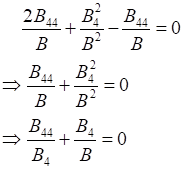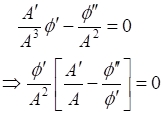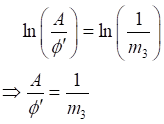|
|
|
|
INHOMOGENEOUS COSMOLOGICAL PERFECT FLUID MODELS IN MODIFIED THEORY OF GENERAL RELATIVITY WITH TIME DEPENDENT-TERM
R. N. Patra 1![]()
1 P.G.
Department of Mathematics, Berhampur University, Odisha, India
|
|
ABSTRACT |
||
|
The
cosmological term is achieved with non-static inhomogeneous cosmological
models when a perfect fluid generates the gravitational field's source.
Einstein's field equations are solved for three physically significant
examples (the vacuum cosmological model, the radiating cosmological model,
and the Zeldevich model) using the gamma law
equation of state. |
|||
|
Received 05 February 2023 Accepted 18 March 2023 Published 31 March 2023 Corresponding Author R. N.
Patra, raghunathpatra09@gmail.com DOI 10.29121/ijetmr.v10.i3.2023.1314 Funding: This research
received no specific grant from any funding agency in the public, commercial,
or not-for-profit sectors. Copyright: © 2023 The
Author(s). This work is licensed under a Creative Commons
Attribution 4.0 International License. With the
license CC-BY, authors retain the copyright, allowing anyone to download,
reuse, re-print, modify, distribute, and/or copy their contribution. The work
must be properly attributed to its author.
|
|||
|
Keywords: Inhomogeneous
Cosmological Model, Perfect Fluid, Radiating Cosmological Model, Zeldevich Model |
|||
1. INTRODUCTION
Barber
(1982) proposed his second
self-creation theory of gravity, which modifies general relativity, in an effort to outperform Einstein's theory. The ideal
fluid in this simplified theory of general relativity just splits the matter
tensor as a reciprocal of the gravitational constant G, rather than gravitating
directly. The local impacts shown in observational studies are predicted by
this idea. Furthermore, by analysing the behaviour of photons and degenerate matter
entities, this theory may be supported or denied. An accurate measurement of
the deflection of light and radio waves passing near the sun, along with the
discovery of anomalous precessions in pulsar orbits over central masses, would
validate or invalidate such a notion. The theory predicts the perihelia of
planets with the same precision as general relativity and in that regard; it is in agreement with observation to within 1%. In the limit ![]() .
.
In every way, this revised theory is similar to Einstein's theory. Many authors have examined the modified theory of general relativity from various perspectives. The Friedman-Barber field equations have been solved by Pimentel (1985) using the power law dependency of the scalar field on the scale factor as an assumption. In generalising Pimentel's work Pimentel (1985), Venkateswarlu & Reddy (1990), Soleng (1987) has obtained solutions for the vacuum-dominated, dust-filled universe of the flat FRW spase-time. Bianchi cosmological solutions of VIo type are found in the works of Reddy & Venkateswarlu (1989), both in vacuum and with perfect fluid pressure equivalent to the energy density. When the source of the gravitational field is a perfect fluid, Venkateswarlu & Reddy (1990) have also built spatially homogenous and anisotropic Bianchi type-1 cosmological macro models.
Space homogeneous and anisotropic Bianchi type-II and III cosmological models have been obtained by Shanthi & Rao (1991) in both vacuum and stiff fluid conditions. Carvalho (1996) obtained a homogenous and isotropic model of the primitive universe in which the gamma parameter of the "gamma law" state equation continually varies with cosmological time. He also presented a unified description of the primitive universe between the inflationary period and the epoch dominated by radiation. Shri Ram & Singh (1998) have obtained a spatially homogeneous and isotropic R-W model of the universe in the presence of perfect fluid by using the ‘gamma law” equation of state. Mohanty et al. (2000) have obtained vacuum and Zeldovich fluid models for plane symmetric anisotropic homogeneous space-time. Mohanty et al. (2002), Mohanty et al. (2003) have obtained an anisotropic homogeneous Bianchi Type-1 cosmological micro model in Barber’s second theory of gravitation wherein the scalar field describes the elementary particles and their interactions Srivastav & Sinha (1998). Also, they have obtained a micro and macro cosmological model in the presence of a massless scalar field interacted with perfect fluid. Panigrahi & Sahu (2003), Panigrahi & Sahu (2002), Panigrahi & Sahu (2003), Panigrahi & Sahu (2004) have obtained plane symmetric inhomogeneous macro models in Barber’s second theory of gravitation. Sahu and Bianchi Type-1 vacuum models have been obtained by Sahu & Panigrahi (2003). Sahu & Panigrahi (2006), Sahu et al. (2010) have investigated Masonic perfect fluid models in modified theory of general relativity.
The vitality energy tensor of matter, which is produced by a idealize liquid, is ordinarily the subject of examination for relativistic models. But to get more reasonable models, one must consider the consistency component in cosmology has pulled in the consideration of numerous analysts because it can account for tall entropy of the display universe Weinberg (1971), Weinberg (1972). The tall entropy by baryon and the momentous degree of isotropy of microwave infinite foundation radiation recommends that dissipative impacts in cosmology ought to be considered. Furthermore, it's over here. Thick impacts are anticipated to happen due to a few forms. These are the decoupling of neutrinos amid the radiation time and the decay of matter and radiation amid the recombination time Kolb & Turner (1990), gravitational string generation Turok (1988) and Barrow (1988) and molecule creation impact within the terrific unification time. Murphy (1973) illustrated that the presentation of bulk thickness can anticipate the peculiarity of the enormous bang. therefore, one would need to consider the nearness of fabric dissemination other than the idealize liquid to get practical cosmological models (see Gron (1990) for an audit of cosmological models with bulk consistency).
To our information none of the creators has examined the
altered hypothesis of common relativity for plane symmetric inhomogeneous space
time in nearness of idealize liquid with time subordinate term![]() . In this paper, we have examined the consistency of this
theory in the context of a perfect fluid.
. In this paper, we have examined the consistency of this
theory in the context of a perfect fluid.
2. Field Equations
Here we consider the space time portrayed by inhomogeneous
metric of the frame
![]() Equation 1
Equation 1
Where A, B are functions of ‘x’ and’ t’.
The field equations in Barbers second self-creation theory with time dependent cosmological constant are
![]() Equation
2
Equation
2
Where ![]() ,
Equation 3
,
Equation 3
The vitality force tensor ![]() for idealize
liquid is given by
for idealize
liquid is given by
![]() Equation 4
Equation 4
Together with ![]() Equation 5
Equation 5
In commoving co-ordinate system the surviving components of the field equations (2)-(5) for the space time (1) are
![]() Equation 6
Equation 6
![]() Equation
7
Equation
7
![]() Equation 8
Equation 8
![]() Equation 9
Equation 9
![]() Equation 10
Equation 10
Here after wards the prime (') and the subscript “4” denotes partial differentiation w.r.to x and t respectively.
In order to solve the field equations for obtaining solutions in explicit forms, we may consider different equation of state. As the metric potentials are functions of x and t, it is difficult to solve the field equations (6)-(10) for non-static case. Hence, we consider the following particular cases.
Case-1:![]()
In this case the field equations (6)-(10) reduces to
![]() Equation 11
Equation 11
![]() Equation 12
Equation 12
![]() Equation 13
Equation 13
![]() Equation 14
Equation 14
Here we have the system of four equations in five unknowns. In order to make the system consistent, we take the help of gamma law equation of state
![]()
2.1. VACUUM
MODEL ![]()
For this case equations (11)-(14) reduce to
![]() Equation
15
Equation
15
![]() Equation
16
Equation
16
![]() Equation 17
Equation 17
![]() .
Equation
18
.
Equation
18
Using equation (16) in equation (15), we obtain

![]()
![]() Equation 19
Equation 19
Integrating equation (19), we obtain
![]() Equation 20
Equation 20
Where ![]() are constants of integration.
are constants of integration.
Now using equation (20) in equation (17) we get
![]()
 Equation 21
Equation 21
For simplification if we consider![]() is a function
of ‘t’ only then equation (18) reduce to
is a function
of ‘t’ only then equation (18) reduce to
![]() Equation 22
Equation 22
With the help of equation (20), equation (22) reduces to
![]()

Integrating we get

Again integrating
![]() Equation 23
Equation 23
Where ![]() are constants of integration.
are constants of integration.
If we consider ![]() is a function
of ‘x’ only then equation (18) reduce to
is a function
of ‘x’ only then equation (18) reduce to

![]() Equation 24
Equation 24
Integrating equation (2.4), we obtain

![]() Equation 25
Equation 25
Again integrating equation (25), we get
![]() Equation 26
Equation 26
Where ![]() and
and ![]() are constants of integration.
are constants of integration.
If we consider ![]() is a separable
function of x and t and in the form of
is a separable
function of x and t and in the form of ![]() with zero
separable constant then the Barbers scalar
with zero
separable constant then the Barbers scalar ![]() From equation
(18) can be obtained as
From equation
(18) can be obtained as
![]() Equation 27
Equation 27
Where ![]() is a constant of integration.
is a constant of integration.
Further, if we are consider ![]() is a separable
function of x and t and in the form of
is a separable
function of x and t and in the form of ![]() with zero separable constant, then Barbers scalar
with zero separable constant, then Barbers scalar ![]() from equation
(18),can be obtained as
from equation
(18),can be obtained as
 . Equation 28
. Equation 28
Hence the Vacuum cosmological model in second self
creation theory of Barber can determined for any arbitrary metric potential![]() .
.
2.2. Radiating
Model: ![]()
In this case, equating equation (11) and (12), we find
![]() Equation 29
Equation 29
On integration, equation (29) yields
![]() Equation 30
Equation 30
where ![]() and
and ![]() are constants of integration. Now using (30) in
equation (13), we obtain
are constants of integration. Now using (30) in
equation (13), we obtain ![]()

 .
Equation 31
.
Equation 31
Further using equation (30) and ![]() in equation (14), we get
in equation (14), we get
![]() Equation 32
Equation 32
For the simplification, if we consider ![]() then equation (32) reduces to
then equation (32) reduces to
![]() Equation
33
Equation
33
This yield on intrgration
![]() Equation 34
Equation 34
Where ![]() and
and ![]() are constants of integration.
are constants of integration.
If we consider![]() , then equation (32) reduces to
, then equation (32) reduces to
![]() Equation 35
Equation 35
Which on integration yields
![]() Equation
36
Equation
36
Where ![]() and
and ![]() are constants of integration.
are constants of integration.
Using (34) and (36) in equation (31), we get
 Equation 37
Equation 37
Or
 Equation 38
Equation 38
Also, if ![]() is a separarable function of
x and t and in the form of
is a separarable function of
x and t and in the form of ![]() with zero
separable constant then equation (32) yields
with zero
separable constant then equation (32) yields
![]() Equation 39
Equation 39
Where ![]() is a constant of integration.
is a constant of integration.
Further, if we consider![]() , then equation (32) yields
, then equation (32) yields
 Equation 40
Equation 40
Hence the radiating cosmological model in second self
creation theory of Barber can be determined for any arbitrary metric potential![]() .
.
Using (39) and (40) in equation (31), we can get another
two values of![]()
2.3. Zeldevich Model: ![]()
In this case the model doesn’t exist.
3. Conclusion
In this paper a plane symmetric inhomogeneous cosmological model has been constructed by taking perfect fluid along with time-depended cosmological constant term. Also, I have studied the consistency of this theory to the case of a perfect fluid in three different cases. The Vacuum and radiating cosmological model exists in second self creation theory of Barber and can be determined for any arbitrary metric potential, but in case of Zel’dovich model it doesn’t exist.
CONFLICT OF INTERESTS
None.
ACKNOWLEDGMENTS
None.
REFERENCES
Barber, G. A. (1982). On Two “Self-Creation” Cosmologies. Gen Relat Gravit 14, 117–136. https://doi.org/10.1007/BF0075691.
Barrow, J. D. (1988). Nucl. Phys., B. 310, 743.
Carvalho, J. C. (1996). Unified Description of the Early Universe. Int J Theor Phys 35, 019–2028. https://doi.org/10.1007/BF02302426.
Gron, O. (1990). Viscous Inflationary Universe Models. Astrophys Space Sci 173, 191– 225. https://doi.org/10.1007/BF00643930.
Kolb, E. W., & Turner, M.S. (1990). The Early Universe, Additson – Wesley, U.S.A.
Mohanty, G., Mishra, B., Das, R. (2000). Bull. Inst. Math. Academia Sinica, 28,43.
Mohanty, G., Panigrahi, U. & Sahu, R. (2002). Exact Bianchi Type-I Cosmological Micro-Model in Modified Theory of General Relativity. Astrophysics and Space Science, 281, 633–640. https://doi.org/10.1023/A:1015858621340.
Mohanty, G., Sahu, R. & Panigrahi, U. (2003). Micro and Macro Cosmological Model in Barber's Second Self-Creation Theory. Astrophysics and Space Science 284, 1055–1062. https://doi.org/10.1023/A:1023306103130.
Murphy, G.L. (1973). Phys. Rev., D 8. https://doi.org/10.1103/PhysRevD.8.4231.
Myung, S., & Cho, B.M. (1986). Mod. Phys. Lett., A 1, 37.
Panigrahi, U., & Sahu, R. (2004). Plane Symmetric Cosmological Macro Models in Self-creation Theory of Gravitation. Czechoslovak Journal of Physics 54, 543–551 https://doi.org/10.1023/B:CJOP.0000024957.99564.97.
Panigrahi, U.K.,
& Sahu R. C. (2002). Science Letters, Allahabad, India, 25, 11, 12.
Panigrahi, U.K., & Sahu, R.C. (2003). Bull. Cal. Math. Soc. India, 95, 3, 183.
Panigrahi, U.K., & Sahu, R.C. (2003). Theo. And Appl. Mech., 30, 163.
Pimentel, L. O. (1985). Exact Self-Creation Cosmological Solutions. Astrophys Space Sci, 116, 395–399. https://doi.org/10.1007/BF00653794.
Reddy, D.R.K., & Venkateswarlu,
R. (1989). Astrophysc. Space
Sci., 155, 135.
Sahu, R.C., Mohapatra, L.K., & Mohanty G. (2010). Romanian Reports in Physics,
62(2), 249-262.
Sahu, R.C, & Panigrahi, U. K. (2006). Astrophys Space Sci., 306, 179.
Sahu, R.C, & Panigrahi, U. K. (2003). Astrophys. Space Sci., 288, 601.
Shanthi, K., & Rao, V. U. M. (1991). Bianchi Type-II and III Models in Self-Creation Cosmology. Astrophys Space Sci 179, 147–153. https://doi.org/10.1007/BF00642359.
Shri Ram & Singh, C. P. (1998). Astrophys. Space Sci., 257, 123.
Soleng, H. H. (1987b). Astrophys.
Space Sci., 102, 67.
Srivastav, S.K, & Sinha, K. P. (1998). Aspects
of Gravitational Interactions, Horizons in World Physics, Noya Science Publishers Inc., Commack,
New York, 225, 111.
Turok, N. (1988). Phys. Rev.
Lett., 60, 549.
Venkateswarlu, R., & Reddy, D. R. K. (1990). Bianchi Type-I Models in Self-Creation Theory of Gravitation. Astrophys Space Sci, 168, 193–199. https://doi.org/10.1007/BF00636864.
Weinberg, S. (1971). Astronomical Physics Journal,
168, 175.
Weinberg, S. (1972). Gravitation and Cosmology, Wiley and Sons.
|
|
 This work is licensed under a: Creative Commons Attribution 4.0 International License
This work is licensed under a: Creative Commons Attribution 4.0 International License
© IJETMR 2014-2023. All Rights Reserved.


